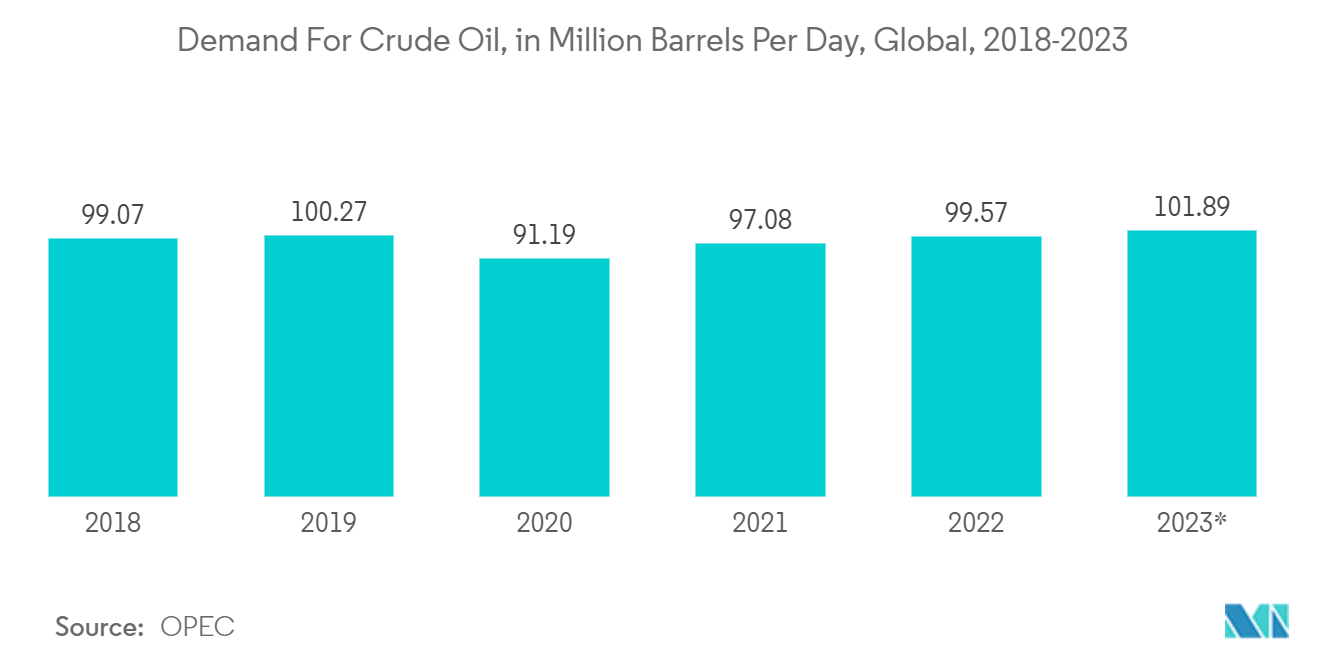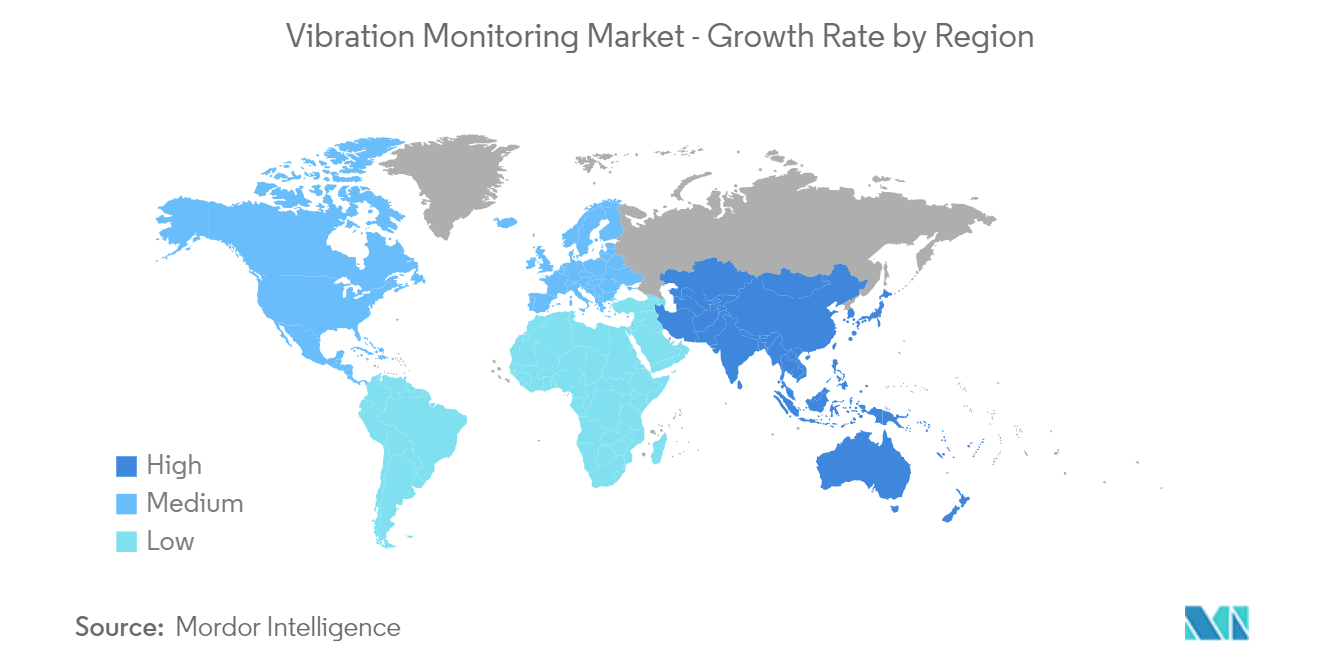Market Trends of Vibration Monitoring Industry
Oil and Gas to Hold Significant Market Share
- Oil and gas operations operate in extreme operating environments, such as offshore drills and petrochemical refineries. There are severe financial and environmental consequences for any mechanical defeat. Thus, the detection and prevention of unpredictable oil and gas machinery and component issues are mandated in many parts of the world. The flammable oil price environment expands the adoption of predictive maintenance technologies, as these help organizations cut operational expenses by optimizing maintenance scheduling and driving productivity.
- The oil and gas industry is at the forefront of adopting innovative technologies to optimize operations, enhance efficiency, and ensure safety in the rapidly evolving landscape of the (IoT). This industry is subject to strict regulatory standards to ensure operational safety and environmental protection. Vibration monitoring is a proactive measure that helps companies comply with these regulations. By leveraging vibration sensors and adopting a proactive approach to maintenance, the oil and gas industry can optimize asset performance, enhance safety, and achieve substantial cost savings.
- The oil and gas industry is anticipated to dominate the expanding Market. The energy and power industry includes several segments, such as coal, nuclear power, minerals, and clean fuels. The raised spending from the government and the private sector on alternative energy and power sources in developed and developing nations is resulting in the installation of more additional energy and power plants, thus fueling the need for vibration monitoring procedures. For instance, in March 2022, the Board of Oil India approved an investment of INR 6,555 crore (USD 839.49 million) for the Numaligarh petrochemical project. Such projects will enhance the application opportunities for vibration monitoring systems.
- In addition, in January 2022, Indian Oil Corp. Ltd. (IOCL) announced plans to extend its city gas distribution (CGD) industry, looking to invest INR 7,000 crore (USD 918.6 million). Further, in May 2022, ONGC announced plans to invest USD 4 billion from FY22-25 to increase its exploration efforts in India. Such initiatives may further propel the studied market growth.
- Vibration monitoring solutions are critical in the oil and gas industry as they ensure that the production machinery is operational and downtime is minimized, lowering operating costs and increasing productivity and monetary gains. A vibration monitoring system aids in the reduction of unplanned outages and the optimization of machine performance, thus reducing maintenance and repair costs.
- The demand for downhole vibration monitoring and control systems is expected to increase significantly in the coming years to increase profitability and reduce downtime in upstream operations. According to METI (Japan), in 2022, the import volume of crude oil from the United Arab Emirates to Japan reached more than 60.3 million kiloliters. The majority of nearly 30 million kiloliters comprised oil from the Murban oil field, followed by oil from Das Island at around 17.7 million. The applications of the downhole vibration monitoring control system have been expected to grow further with upcoming exploration and drilling projects in countries such as the United States, Saudi Arabia, and the United Arab Emirates.
- In addition, according to OPEC, the international Crude oil consumption reached 99.57 million barrels a day in 2022, which included biofuels is projected to grow to 101.89 million barrels per day in 2023. Furthermore, the adoption of vibration monitoring is high in the oil and gas sectors. It is used for predictive analysis, which helps manufacturers increase their productivity and maximize operational efficiency. Condition monitoring is required for vibration analysis on vital machines to manage and prevent unexpected shutdowns due to unforeseen machinery failure within the oil and gas sector.

Asia-Pacific to Witness Significant Market Growth
- China is a prominent global manufacturing center with the largest population globally, and it is increasing investments in the power and infrastructure sectors. The Chinese government has previously declared investments worth USD 78 billion to construct 110 nuclear power plants, which are scheduled to become operational by 2030. These advancements are anticipated to expand the potential for adopting contemporary technologies, such as vibration monitoring solutions, to facilitate condition-based monitoring.
- Increasing adoption and awareness of predictive maintenance and vibration monitoring technologies in the power, oil and gas, cement, chemical and petrochemical, and automotive firms, coupled with government ambitions, such as 'Made in China 2025', may design sustained demand for vibration monitoring in Asia-Pacific during the forecast period.
- Despite the falling hydrocarbon energy prices, there is a continued focus on oil and gas exploration activities to achieve energy self-sufficiency by NOCs, such as CNPC in China. These activities are anticipated to create a robust demand for vibration-monitoring solutions to monitor and facilitate the maintenance of oil and gas equipment and infrastructures. China has the most significant shale oil and gas reserve worldwide and focuses on tapping the same through joint ventures with oil and gas companies.
- Vibration monitoring is an integral part of a predictive maintenance program. Regularly inspecting and monitoring the condition of oil and gas pumps can help identify and address potential problems before they cause failure, thus saving time and money by avoiding unplanned outages and unnecessary repairs. Increasing investment in various applications in the studied market may further propel growth. According to IBEF, India's LNG import was predicted at 2,266 million metric standard cubic meters (MMSCM) in January 2023. According to IEA, natural gas consumption in India is expected to grow by 25 BCM, recording an average annual boost of 9 percent until 2024.
- India boasts one of the largest automotive markets globally. As per SIAM, approximately 21.2 million vehicles were sold in India during FY 2023. In June 2022, domestic passenger vehicle wholesales witnessed a 2.2 percent surge, reaching 3.27 lakh units, while two-wheeler sales experienced a 1.7 percentage increase, totaling 13.30 lakh units, as reported by the Society of Indian Automobile Manufacturers (SIAM). Additionally, the government aims to achieve a 40 percent electric vehicle sales penetration for buses, 30 percentage for private cars, and 70 percent for commercial vehicles by 2030. Therefore, with the rising automotive industry and growing sales capabilities, the need for vibration monitoring in the sector is expected to increase.
- Preventive maintenance has emerged as a crucial requirement in the Food and Beverage Industry. Furthermore, vibration monitoring can effectively avert downtime, identify fundamental machine health, and minimize energy expenses by anticipating impending equipment malfunctions and rectifying them proactively. The escalating investments in the food sector are expected to generate abundant prospects for the market and vendors to cater to the demand.
- For instance, According to the (MFDS), the food industry's total production value in South Korea accounted for approximately 3.15 percent of the country's GDP in 2022, a slight increase from 2.91 percent in the previous year. Additionally, South Korea aims to enhance the vitality of five significant sectors within the local food industry as part of its 2030 objective to double the sector's value. Similarly, according to the Korea Food and Drug Administration, the Korean food industry has experienced significant growth in recent years, with an annual increase of approximately 8.1 percent. These capabilities will contribute to the market's demand.

